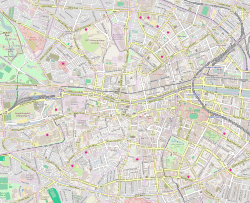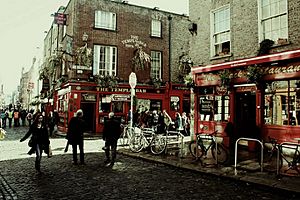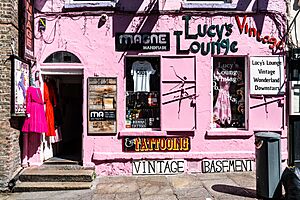Temple Bar, Dublin facts for kids
Quick facts for kids
Temple Bar
Barra an Teampaill
|
|
|---|---|
|
Neighbourhood of Dublin
|
|

Clockwise from top: Shops along Crown Alley, the OIiver St. John Gogarty bar, pedestrians on Fownes Street
|
|
| Country | Ireland |
| City | Dublin |
| Postal district |
D02
|
Temple Bar (Irish: Barra an Teampaill) is a lively area in central Dublin, Ireland. It sits on the south bank of the River Liffey. This popular spot is known as Dublin's 'cultural quarter'. It is also a fun place for tourists, especially at night.
Temple Bar is bordered by the Liffey to the north and Dame Street to the south. To the east is Westmoreland Street, and to the west is Fishamble Street. It is part of the Dublin 2 postal district.
Contents
History of Temple Bar
How Temple Bar Got Its Start
Long ago, in medieval times, this area was called St. Andrews Parish. It was a suburb just outside the city walls. But it became unsafe in the 1300s due to attacks. So, people stopped using the land for a while.
In the 1600s, the area was developed again. Wealthy English families built houses and gardens there. At that time, the River Liffey's edge was further inland than it is today. Over time, marshy land by the river was walled off and filled in. This allowed new houses to be built right up to the water's edge.
The fronts of these new houses created a new street. The name "Temple Bar" first appeared on a map of Dublin in 1673. This map, made by Bernard de Gomme, showed the new land and buildings.
Where Did the Name Temple Bar Come From?
Many people believe Temple Bar got its name from the Temple family. Sir William Temple built a house and gardens there in the early 1600s. He had moved to Ireland in 1599. Sir William was a secretary to important people. Later, he became the head of Trinity College from 1609 until he passed away in 1627.
However, the name Temple Bar might have also come from a famous area in London. There was a well-known `Temple Bar district in London`. This London area had a main toll-gate into the city for many centuries.
Important Events in Temple Bar's Past
In 1742, a very famous musical work, `Handel's Messiah`, was first performed. This happened on April 13th on Fishamble Street, near Temple Bar. Even today, the Messiah is performed there every year on the same date.
In 1791, a group called the Society of the United Irishmen was formed. This group wanted to bring about political change in Ireland. They had their first meeting in a tavern on Eustace Street.
During the 1800s, Temple Bar became less popular. By the 1900s, many buildings were empty and falling apart.
Saving Temple Bar
In the 1980s, a transport company wanted to buy and knock down buildings in Temple Bar. They planned to build a bus station there. While they were planning, the company rented out the buildings cheaply. This attracted small shops, artists, and art galleries to the area.
People protested against the bus station plan. Groups like An Taisce, residents, and traders worked together. Their protests helped stop the project. Then, the Irish leader, Charles Haughey, helped get money to save the area. In 1991, the government created a company called Temple Bar Properties. Their job was to make Temple Bar a cultural center for Dublin.
In 1999, there was an effort to discourage large groups celebrating "Stag Parties" and "Hen Nights" in Temple Bar. This was mainly because of noisy behavior. While the rules might have relaxed, noise and anti-social behavior can still be a problem at night.
Temple Bar Today
Temple Bar is now home to many cultural places. These include the Irish Photography Centre and the Irish Film Institute. You can also find the Ark Children's Cultural Centre and the Button Factory, a music venue. Other places include Temple Bar Gallery and Studios and the Project Arts Centre. The Gaiety School of Acting and the Irish Stock Exchange are also in the area.
At night, Temple Bar is a busy place for fun. It has many nightclubs, restaurants, and bars. These places are very popular with tourists. Famous pubs in the area include The Temple Bar pub and The Porterhouse.
The area has two main squares that have been updated. These are Meetinghouse Square and Temple Bar Square. On Saturdays and Sundays, you can find the Temple Bar Book Market in Temple Bar Square. Meetinghouse Square is named after a nearby Quaker Meeting House. It is used for outdoor movie showings in the summer. Since 2004, it also hosts 'Speaker's Square' and the 'Temple Bar Food Market' on Saturdays.
The 'Cow's Lane Market' is another popular spot. It is a market for fashion and design. You can find it on Cow's Lane every Saturday.
You can still see parts of a very old building in Temple Bar. This is the 13th-century Augustinian Friary of the Holy Trinity. It is visible within an apartment and restaurant complex called 'The Friary'.
Temple Bar in Pop Culture
- The Bollywood movie Ek Tha Tiger had a song filmed in the area.
- Irish singer Billy Treacy released a funny song about Temple Bar.
- The Irish Country singer Nathan Carter also released a song called Temple Bar.
See also
 In Spanish: Temple Bar para niños
In Spanish: Temple Bar para niños







